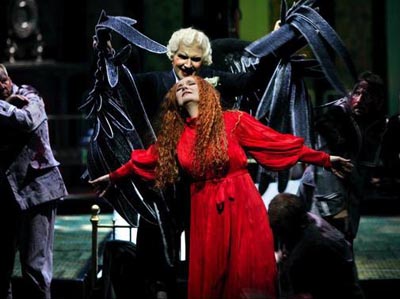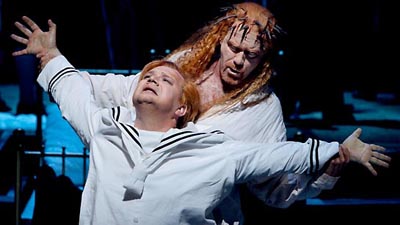 In his final opera, Parsifal—whose motifs had been built over a thirty-year period—Wagner fulfilled his vision of operatic “music theater” as something that would go far beyond the classical notion of a drama told in song and music.
In his final opera, Parsifal—whose motifs had been built over a thirty-year period—Wagner fulfilled his vision of operatic “music theater” as something that would go far beyond the classical notion of a drama told in song and music.
The Parsifal of this season’s Bayreuth Festival—direction by Stefan Herheim and set design by Heike Scheele—was in clear and stunning resonance with Wagner’s intention, and used electrifying manipulation of sets, lighting, costume, movement, and voice to achieve a fusion of space, time, and music.
When this production was first mounted several years ago it produced shock and awe. This season the sight of crimson National Socialist banners unfurling swastikas from the ceiling, while the young Parsifal rises from center stage in Hitler youth corps uniform, still prompted gasps. Yet all was in the artistic service of a remarkable odyssey through the recent history of Germany, from the origins of the first World War, through the rise and fall of the third Reich into a redemptive possible future. And along the way, the singers kept up with outstanding acting and continuously evolving visuals. It was easily the most compelling performance of any kind that I’d ever experienced, and that impression was shared by audience members who thundered, roared, applauded, and stamped their feet in approval.
Near the end of Act I, we (along with the innocent Parsifal) are told by his mentor Gurnemanz the key not only to Wagner’s opera, but also to Herheim’s shimmering production: “Here my son, time becomes space.” Indeed the stuptifying stage design—in which mirrors become portals to hell, the brass bed of Parsifal’s birth becomes a site of incest and death, in which characters exchange identities—worked visual magic, changing time into space, visualizing the past as it materializes into a vibrant, four-dimensional mythic place.
There were two central keys to these morphic resonances: the overall set was designed in homage to Wahnfried, Wagner’s own home in Bayreuth, at first as the troubled site of Parsifal’s youth, later as a field hospital during two world wars, and finally in ruins as a sacred space for symbolic redemption.  The initial footprint of the late Victorian estate seeps through each act, in one variation or another.
The initial footprint of the late Victorian estate seeps through each act, in one variation or another.
The second visual trope used brilliantly, even shockingly, by the production’s designers, is a wig of long red hair. It is the long red hair of Parsifal’s mother, of Kundry his seductress, of Parsifal himself, and of Amfortas, the dying king whose wounds will not heal without the help of the Grail. As the red wig turns up on one and then another of the singers, we watch as personalities—and with them the particular sufferings and longings of each person—move back and forth, just as space and time in this mercurial production change many times throughout the opera’s five hours of performance time.
It’s true, much of what made this Parsifal unimaginably mythic were what could be described as “special effects.” And yet not one morsel of gender-switching, identity-sharing, or temporal morphing was gratuitous. Every minute made complete artistic sense within the metaphysical journey of this story.
Some theatrical productions use sets, lighting, sound, and costumes to establish a context for the action. This one created an entire metaphysics in which—through the sorcery of stagecraft—personalities intertwine, time moves in all directions, historical motives become sensual psychology, and heaven becomes hell.
Even though I was particularly taken by the splendid effect of on-stage soldiers marching off to war, back into the past by way of an enormous projection of WW I battle footage—the true and undeniable star of this production was Wagner’s music, played with a brilliant balance of gravitas and urgency by conductor Philippe Jordan and the Bayreuth Festival Orchestra, who have utterly spoiled me for any other musical ensemble.
Susan Maclean’s Kundry provided sensitive acting although her top notes seemed to weaken during the final act. Burkhard Fritz was a convincing and stalwart Parsifal. But the most beautiful and evocative voice that night belonged to Korean-born Kwangchul Youn, whose Gurnemanz (also King Mark in Tristan) gave rich emotional patina to Wagner’s most poignant words.
It was a Parsifal full of symbolic mischief and depths, where fictional and literal space intertwined. Freud meets Klimt, with some delicious detours through Max Beckmann and Ingmar Bergman.


Enjoyed the description of this Parsifal. But am puzzled at the remark on Susan Maclean whose “top notes seemed to weaken during the final act”. Kundry sings only two words in the third and final act (although she remains physically onstage, but mute, throughout much of its 70-minute length), so any other notes heard from this character were definitely not written by Wagner.
Clearly Andrew I was overcome by the entire experience and momentarily confused the lengthy Act II with the lengthy Act III.
Many thanks for your correction.
Christina